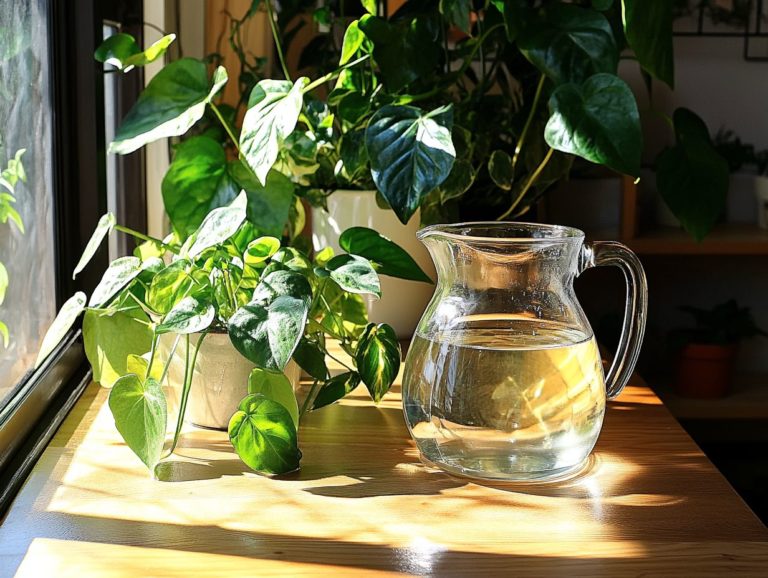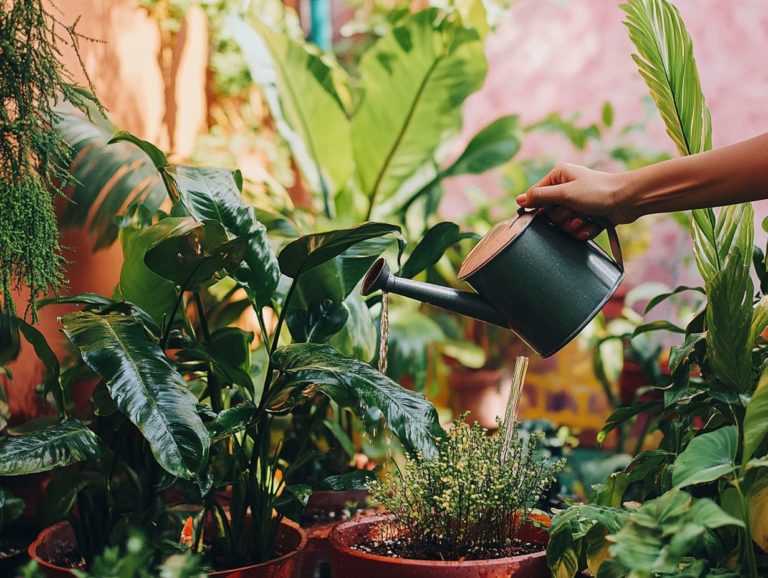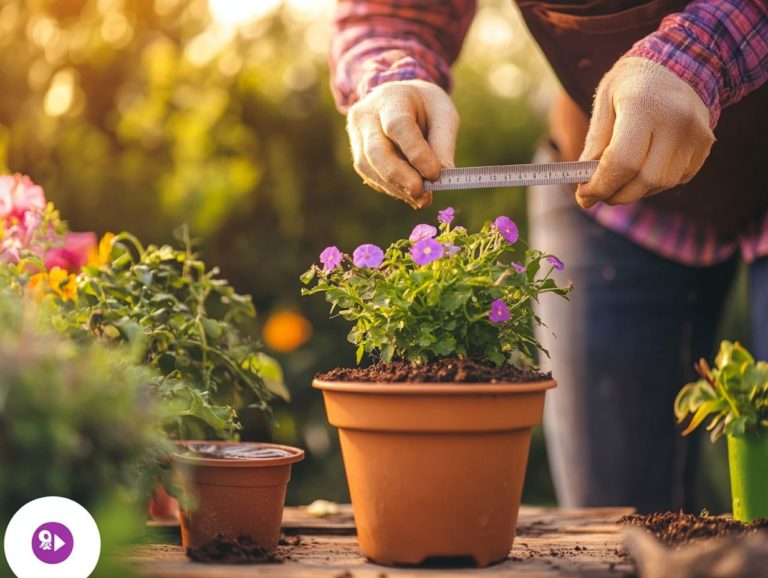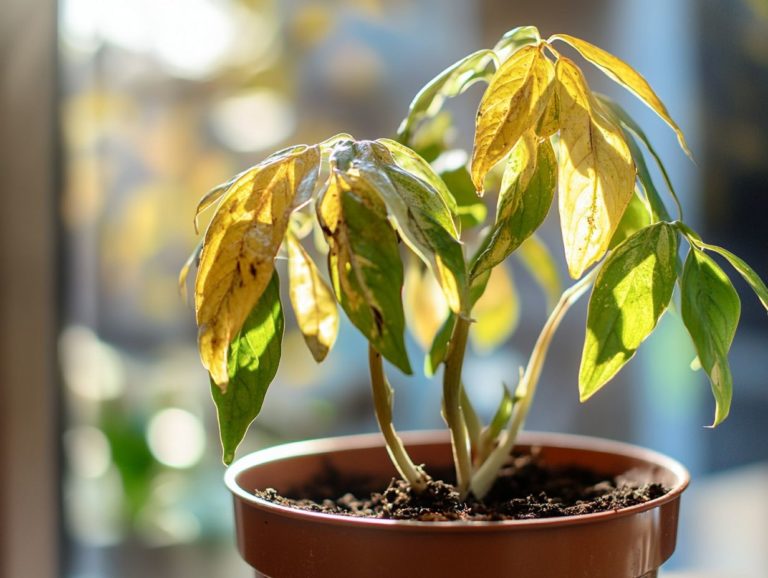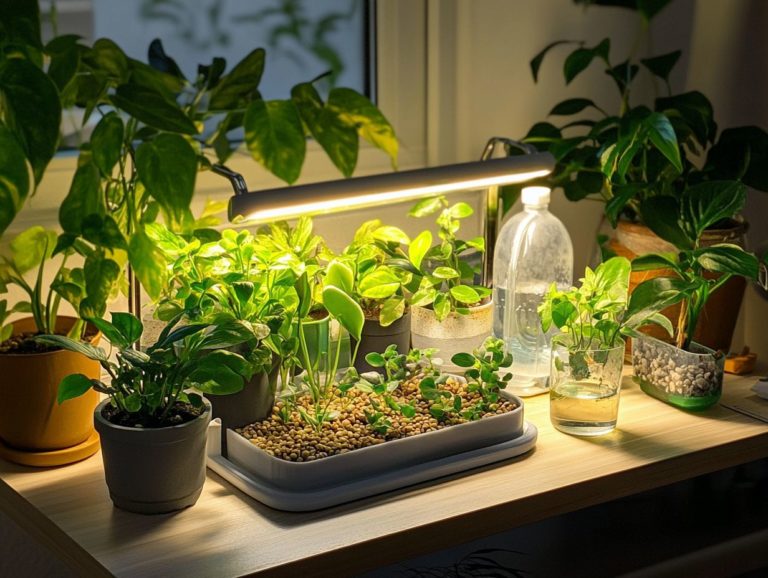Best Practices for Watering Tropical Plants
Tropical plants bring a splash of vibrancy to your home or garden, but they require specific care to truly thrive.
Let s dive into the key factors climate, soil type, and plant species that dictate their watering needs.
You ll learn how to recognize signs of under or over-watering and uncover the best practices for effective watering techniques. Get ready to gather tips to maintain robust, flourishing tropical plants!
Don t miss out on learning how to keep your plants thriving and vibrant!
Contents
Key Takeaways:

- Understand your tropical plants unique watering needs.
- Check the climate, soil type, and plant species for watering frequency.
- Monitor for signs of over or under-watering to keep your plants healthy!
Know Your Tropical Plants Needs
To truly appreciate the needs of tropical plants like Monstera deliciosa and Birds Nest Fern, recognize how factors like water requirements, soil moisture, and environmental conditions impact their health.
Pay attention to their watering schedules, humidity levels, and temperature preferences. This is particularly important given the unique characteristics of tropical environments. For optimal care, consider exploring the best watering techniques for indoor plants.
Factors to Consider When Watering Tropical Plants
When watering tropical plants, consider factors like soil type, drainage holes, and specific water requirements for different species. Using a watering can and a moisture meter can help you find the right watering schedule.
This is especially important during seasonal changes when the rate of how quickly water evaporates can vary greatly.
Climate and Environment
The climate and environment greatly influence tropical plants, which thrive in high humidity and specific temperature ranges. Understanding these factors helps you create an ideal atmosphere for plants like Monstera deliciosa and Birds Nest Fern.
If humidity levels drop too low, you may see signs of stress like brown leaf tips or wilting. High humidity helps the leaves retain moisture and supports healthy photosynthesis.
Temperature is also crucial; most tropical plants prefer a cozy range between 65 F and 85 F. If temperatures swing outside this range, it can disrupt their growth and make them more vulnerable to pests and diseases. Creating an environment similar to their native habitat is vital, along with effective watering practices to support their health.
Soil Type and Drainage
The type of soil and the presence of drainage holes are critical for water retention and the health of your tropical plants. Choose soil rich in organic material to improve moisture management and foster robust root systems.
In tropical conditions, different soil types, like loam and sandy soils, offer unique benefits. Loamy soils provide a balanced environment that nourishes roots while ensuring good drainage.
Sandy soils can benefit from adding organic materials like compost or aged manure, which improves soil structure and moisture retention, essential for preventing stress during dry spells.
Creating drainage holes is equally important; without them, excess water can cause root rot, posing a significant threat to your plants’ health and growth.
Plant Species and Growth Stage
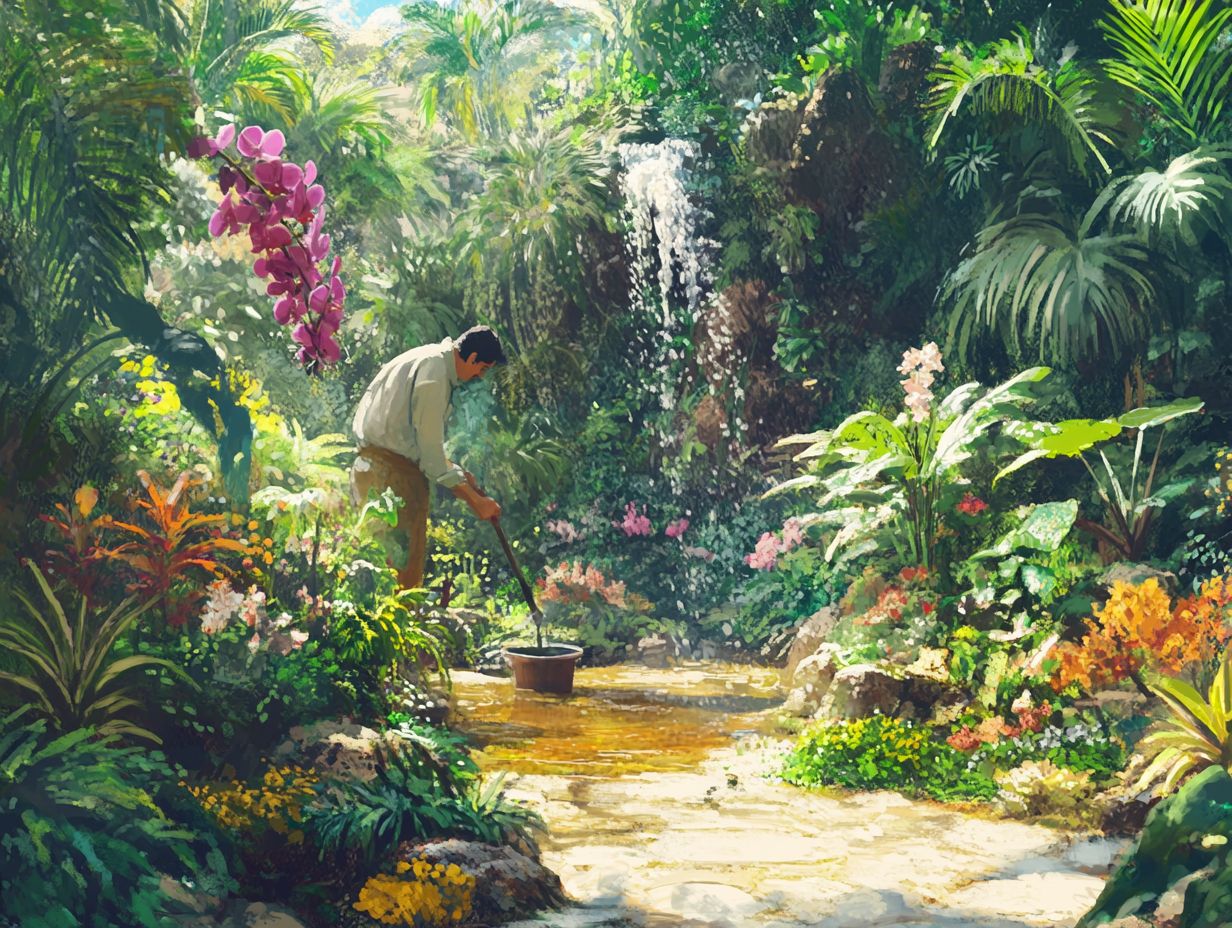
Different tropical plant species have unique water requirements that vary with their growth stages. It’s essential to adapt your watering schedule for optimal plant care. By understanding the specific needs of each plant species, you can ensure healthy development and lush foliage.
For example, young monstera plants thrive on frequent watering to establish robust root systems. Mature monstera require less frequent but more thorough watering. A fiddle leaf fig needs consistent hydration during its vigorous growth phase in spring. For more insights on this topic, you can explore the science of watering indoor plants, as its water demands may decrease during the dormancy of winter.
The humidity in your environment also plays a pivotal role. Plants like orchids thrive in a moist atmosphere, necessitating a different care approach compared to drought-tolerant varieties such as the snake plant. By paying attention to each species’ unique characteristics and growth stages, you can craft tailored care routines that foster their overall well-being.
Signs of Under and Over-Watering
Spotting the signs of under-watering and over-watering is crucial right away for preserving the health of your tropical plants. Both conditions can have bad effects.
If you notice dry soil, it s a clear signal that your plants may be thirsting for more water. Conversely, wet soil could suggest you re giving them too much, jeopardizing their root systems and overall vitality. Watch for these signs to keep your plants thriving!
Identifying Symptoms
Identifying symptoms of water-related stress in tropical plants is crucial for their care. These symptoms often reveal themselves through changes in behavior, like wilting, yellowing leaves, or stunted growth. Observing the soil’s condition whether it’s dry or overly saturated provides vital insights into your plant’s health and watering requirements.
Overly saturated soil can lead to root rot, which you might recognize by its slimy texture and the unpleasant odor wafting from the roots. On the flip side, signs of under-watering often manifest as brittle leaves that curl or become crispy at the edges. Your tropical plants may also show slowed growth or browning leaf tips, indicating they are thirsting for moisture. To ensure you’re watering correctly, refer to this guide on how to properly water indoor plants in soil.
By familiarizing yourself with these indicators, you’ll easily know when to adjust your watering schedules or techniques. This will ensure your plants thrive with vibrant foliage and robust growth.
Best Practices for Watering Tropical Plants
Implementing best practices for watering tropical plants requires you to adopt the right techniques, identify the ideal frequency, and ensure proper application to maintain optimal moisture levels.
Using a watering can offers you the advantage of controlled application. This is particularly beneficial for your delicate indoor plants. With this approach, you can nurture your greenery with precision, ensuring they thrive in their environment. For more insights, explore best practices for indoor plant care.
Frequency and Amount of Water
Determining the right frequency and amount of water is essential for the health of your tropical plants. Each species has its own unique requirements that influence moisture levels. By properly assessing these needs, you can provide adequate hydration without the risk of overwatering.
To achieve this, consider factors such as the species, size, and growth stage of your plants. For example, some tropical plants, like ferns and peace lilies, thrive in consistently moist conditions. Others, such as succulents, prefer drier spells. To learn more about how to care for your plants, check out the best watering schedule for common plants.
A device that measures how wet the soil is can be a game changer in evaluating the soil’s hydration levels. It gives you objective data to guide your watering schedule. Pay attention to the leaves and soil texture as well wilting leaves might indicate dehydration, while overly soggy soil could mean too much water.
By adjusting your watering habits accordingly, you ll cultivate a thriving indoor oasis that flourishes under your care. Start monitoring your plants today for a vibrant and healthy indoor oasis!
Watering Techniques

Using the right watering techniques is crucial for optimizing moisture levels in your tropical plants. Methods like water soaking and using a moisture meter a device that measures how wet the soil is can elevate your plant care practices to new heights. These techniques help you keep the soil moisture just right without jeopardizing your plants’ health.
Soaking allows your pots to absorb water from the bottom up, encouraging deep root growth and ensuring that the entire root system is adequately hydrated. Drip irrigation provides a slow and steady supply of water directly to the roots, minimizing evaporation and reducing the risk of fungal diseases. This helps keep your plants happy and healthy.
Moisture meters are invaluable tools that eliminate the guesswork from watering, giving you real-time insights into soil moisture levels. Using these techniques helps you maintain optimal soil moisture and significantly reduces the likelihood of overwatering or underwatering, promoting the overall vitality of your cherished plants by understanding their specific watering needs.
Tips for Maintaining Healthy Tropical Plants
To maintain healthy tropical plants, act now to ensure your plants thrive! You need a well-rounded approach that includes essential tropical plant care tips, regular repotting, and the judicious use of plant food and organic material.
These practices play a crucial role in ensuring the overall well-being and vitality of your tropical plants, such as Monstera deliciosa and Birds Nest Fern. For optimal care, consider implementing effective watering strategies for large indoor plants, regardless of the environment they inhabit.
Other Factors to Consider
Besides watering, consider other important factors like light exposure, temperature, and humidity levels that significantly influence the plant growth of tropical plants. Understanding these elements is essential for providing comprehensive care and ensuring optimal growing conditions.
Tropical plants flourish in bright, indirect light that closely mirrors their natural habitat. It s important to position them near windows that filter sunlight or use grow lights if natural light falls short to help with their plant health.
Temperature is essential for your plant’s well-being; these plants typically thrive in warmer climates, ideally within the range of 65 F to 85 F. To maintain a stable environment, steer clear of placing them near drafts or heat sources, especially when considering the environment conditions they thrive in.
Humidity is vital as well since tropical plants usually prefer high humidity levels. You can enhance moisture in the air by using a humidifier or positioning your plants on a pebble tray filled with water, which helps your plants grow strong and healthy.
Frequently Asked Questions
What are the best practices for watering tropical plants?
The best practices for watering tropical plants include watering consistently, allowing for proper drainage, using room temperature water, and providing humidity through appropriate watering intervals.
How often should I water my tropical plants?
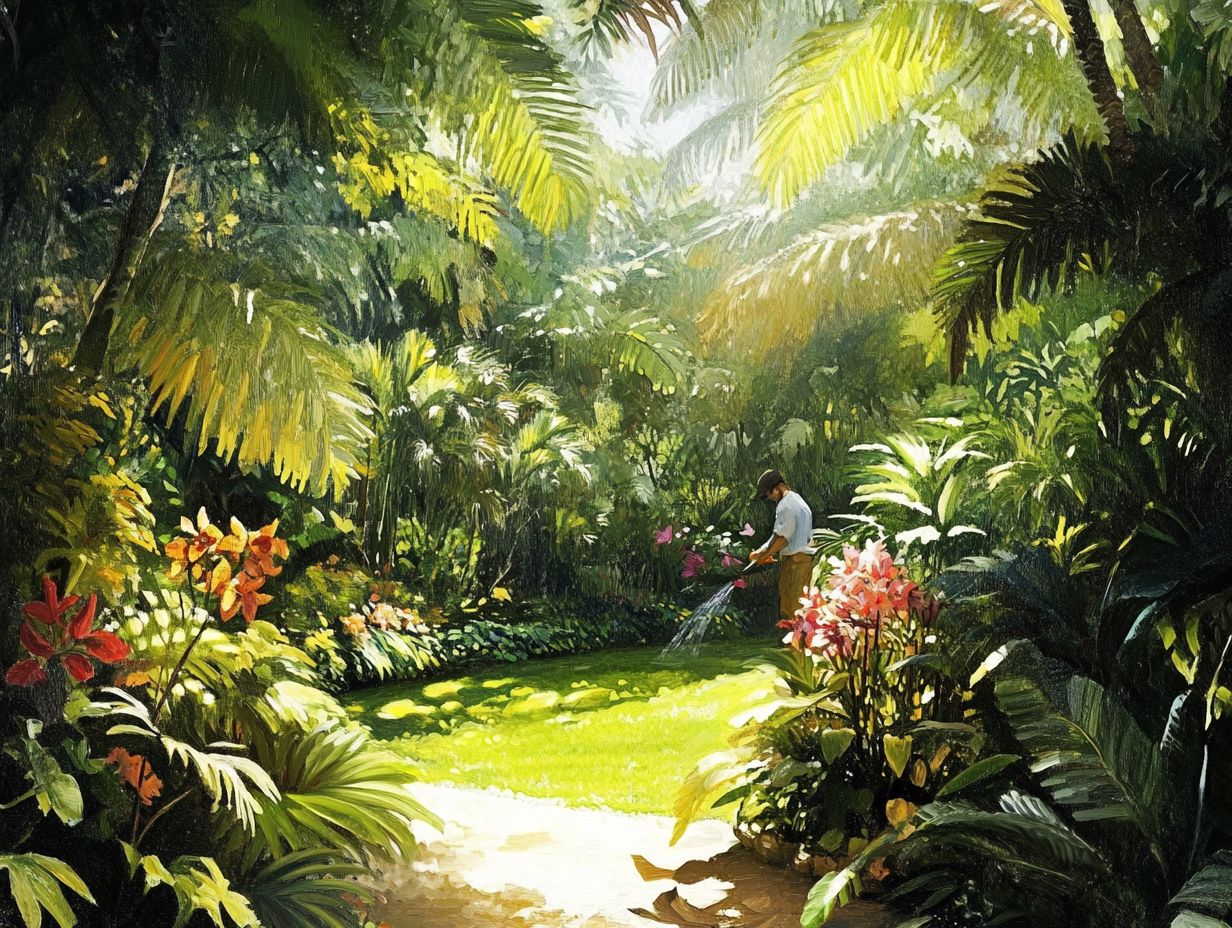
Tropical plants typically require more frequent watering than other types of plants. It is recommended to water them 1-2 times a week, depending on the humidity levels and soil moisture. Ensure you pay attention to the amount of water to avoid underwatering.
What is the best time of day to water tropical plants?
The best time of day to water tropical plants is in the morning or early evening. Avoid watering during the hottest part of the day to prevent evaporation and watering problems that can harm your plants.
Can I use tap water to water my tropical plants?
Tap water can be used to water tropical plants, but it is best to let it sit overnight to allow chlorine and fluoride to dissipate, ensuring better water quality for your plants. Alternatively, you can use filtered or rainwater for watering.
Should I mist my tropical plants?
Misting can help increase humidity for tropical plants. However, it shouldn t be the primary moisture source.
It s best to mist them in the morning. Avoid wetting the leaves in the evening to prevent fungal growth.
How can I tell if my tropical plant needs water?
Wondering if your tropical plant needs a drink? Here s how to find out!
Check the soil moisture using a moisture meter. Stick your finger about an inch into the soil; if it feels dry, it s time to water deeply.
Look for wilting or drooping leaves as signs of dehydration. Your plant s specific care will depend on its container size and water needs.

